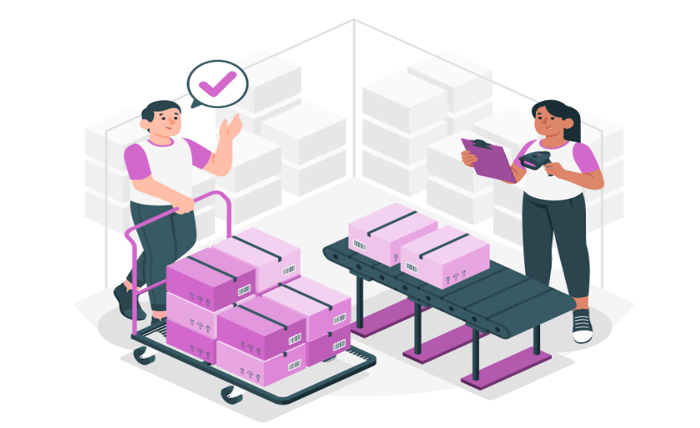
Have you ever walked into a store only to find the product you need is out of stock? Or noticed shelves cluttered with items that no one seems to buy? How does poor inventory management affect a retailer’s profitability and customer loyalty?
According to a 2024 report by IHL Group, global retailers lose over $1.8 trillion annually due to inventory distortion—$1.2 trillion from out-of-stock issues and $600 billion from overstocking. Another study by Retail Systems Research found that 70% of shoppers have experienced stockouts in the past six months, and 45% of them switched to a competitor as a result.
In the highly competitive world of retail, effective inventory management is not just a business function—it’s the backbone of success. Managing inventory efficiently ensures that the right products are available at the right time, optimizing sales while minimizing costs. Poor inventory practices can lead to overstocking, stockouts, lost sales, and ultimately, dissatisfied customers. As the retail landscape evolves with the rise of e-commerce, omnichannel experiences, and ever-changing consumer expectations, inventory management becomes even more critical.
What Is Inventory Management in Retail?
Inventory management in retail involves overseeing the flow of goods from manufacturers to warehouses and from these facilities to the point of sale. It includes ordering, storing, tracking, and controlling stock to meet customer demand without incurring unnecessary costs. The goal is to have the right amount of stock in the right place at the right time, ensuring operational efficiency and customer satisfaction.
Key components of inventory management include:
- Stock forecasting based on demand trends
- Stock replenishment to avoid stockouts
- Stock audits to ensure accuracy
- Inventory categorization (e.g., ABC analysis)
- Integration of technology like inventory management software
The Importance of Effective Inventory Management
Effective inventory management can significantly impact a retailer’s bottom line. Here are some reasons why it is essential:
1. Reduces Costs
Excess inventory ties up cash and leads to additional storage, insurance, and potential obsolescence costs. Efficient management helps reduce carrying costs and improve cash flow.
2. Improves Customer Satisfaction
Customers expect products to be available when they want them. Stockouts can lead to lost sales and damaged brand reputation. On the other hand, overstocking irrelevant products can clutter stores and lead to markdowns. Proper inventory management ensures that customer needs are met consistently.
3. Enhances Forecasting and Planning
Data from inventory systems help retailers better understand sales trends, seasonal demand, and product lifecycle stages. This information is vital for making informed purchasing decisions and improving strategic planning.
4. Increases Efficiency
With streamlined inventory processes, businesses can manage stock levels more efficiently, freeing up employee time for higher-value activities like customer service and sales optimization.
5. Supports Omnichannel Retailing
Today’s shoppers expect a seamless experience across online and offline channels. Inventory management systems integrated with physical stores and e-commerce platforms allow for real-time stock visibility, making possible services like click-and-collect or ship-from-store.
Inventory Management Techniques for Retailers
Retailers can leverage a range of inventory management techniques to improve their operations:
Just-In-Time (JIT) Inventory
JIT is a method where inventory is received only when needed, reducing holding costs. While it can lead to major cost savings, it requires precise forecasting and reliable suppliers to avoid stockouts.
ABC Analysis
This technique categorizes inventory into three groups:
- A items: High-value products with low sales frequency
- B items: Moderate value products with moderate sales frequency
- C items: Low-value products with high sales frequency
Prioritizing management efforts based on this categorization helps focus resources where they matter most.
Dropshipping
In dropshipping, retailers don’t hold inventory but transfer customer orders to a third party (usually a wholesaler or manufacturer) who ships directly to the customer. This method reduces inventory risk but can limit control over fulfillment and customer experience.
Cycle Counting
Instead of conducting a full physical inventory annually, cycle counting involves regularly counting portions of inventory throughout the year. This helps maintain inventory accuracy with minimal disruption to operations.
Safety Stock
Keeping a small buffer of extra inventory (safety stock) can protect against unexpected demand spikes or supply chain disruptions. However, it’s essential to balance it carefully to avoid excessive holding costs.
The Role of Technology in Modern Inventory Management
Technology has revolutionized inventory management in retail, making it more accurate, efficient, and integrated than ever before. Key technological advancements include:
Inventory Management Software
Modern software solutions automate key processes like reordering, stock level monitoring, and forecasting. These tools often come with customizable dashboards and real-time reporting, giving retailers full visibility into their inventory at all times.
Radio Frequency Identification (RFID)
RFID tags help retailers track products throughout the supply chain in real time. Unlike traditional barcodes, RFID can track multiple items simultaneously, reducing labor costs and increasing inventory accuracy.
Artificial Intelligence and Machine Learning
AI-driven inventory systems can predict demand patterns, optimize reorder points, and even identify potential supply chain risks. Machine learning algorithms become smarter over time, improving inventory forecasting accuracy.
Cloud-Based Systems
Cloud technology allows for centralized inventory management across multiple locations, making it easier for retailers to manage stores, warehouses, and e-commerce platforms from a single interface.
Common Inventory Management Challenges
Despite the tools and techniques available, inventory management still presents challenges:
- Inaccurate data: Poor tracking can lead to significant discrepancies between actual and recorded inventory levels.
- Poor demand forecasting: Unpredictable market trends and consumer behavior can cause inventory issues.
- Supply chain disruptions: Global events, supplier issues, or transportation delays can cause stock shortages. For example, efficient forklift hire options can mitigate delays in unloading and handling goods, but the wrong equipment or poor coordination can lead to operational bottlenecks.
- Overstocking and understocking: Misjudging demand leads to financial loss and operational inefficiencies.
Addressing these challenges requires a combination of good practices, robust systems, and a proactive approach to supply chain management.
Best Practices for Retail Inventory Management
To optimize inventory management, retailers should consider these best practices:
- Regular audits to catch discrepancies early
- Strong supplier relationships to ensure reliability
- Implementing inventory KPIs like turnover ratio and sell-through rate
- Adopting omnichannel inventory visibility for a seamless customer experience
- Employee training to ensure best practices in handling and tracking stock
- Embracing automation wherever possible to reduce human error
Conclusion
Inventory management in retail is far more than just keeping track of products—it’s a dynamic and strategic function that impacts nearly every aspect of business success. With the right mix of techniques, technology, and best practices, retailers can optimize their inventory systems to reduce costs, boost customer satisfaction, and stay competitive in a rapidly changing marketplace. Whether operating a small boutique or a global retail chain, mastering inventory management is key to achieving sustainable growth and profitability.




